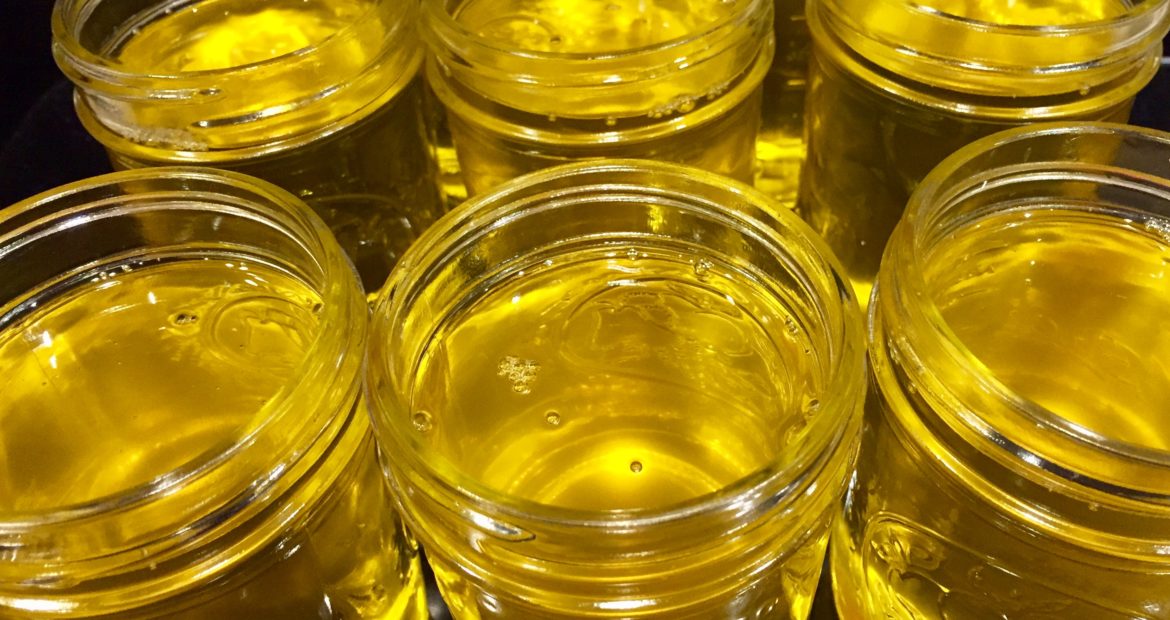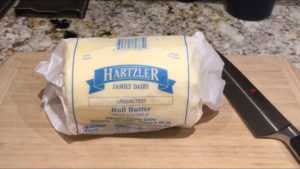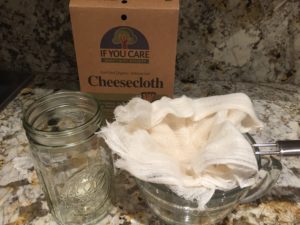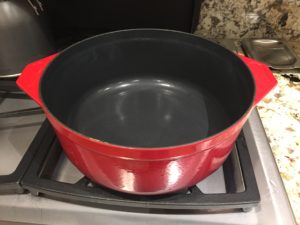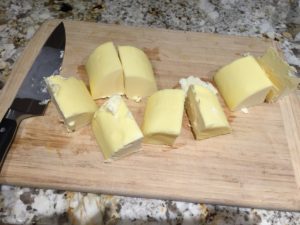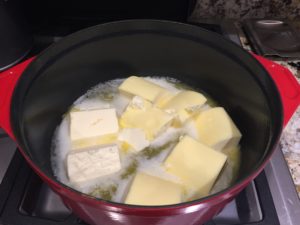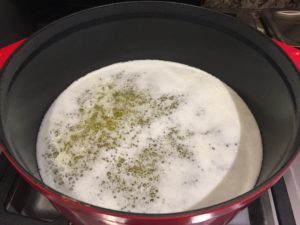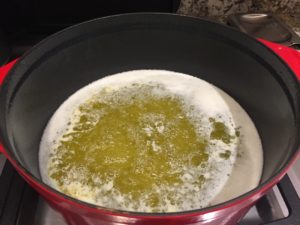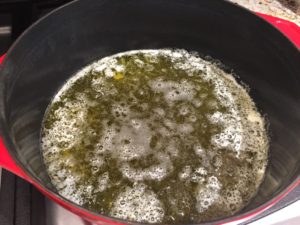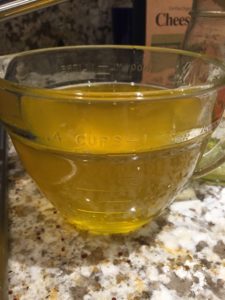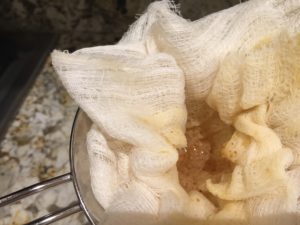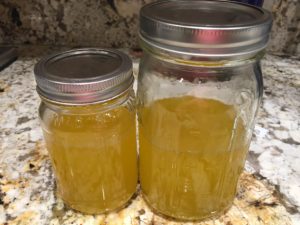Ghee has been used for thousands of years in Ayurveda for cooking and to promote health and healing internally and externally. Ghee is a sattvic food, promoting physical strength, a strong and pure mind, good health, and longevity. Ghee is good for Vata, Pitta and Kapha dosha.
Benefits of Ghee
Ideal For Cooking
- High smoke point (450-482 °F) allows you to cook and fry foods without ghee breaking down into free radicals.(1, 2)
- Ghee does not spoil easily so it does not need refrigeration.
Lactose and casein free
- Ghee is made from butter but the milk solids and impurities have been removed, so most people who are lactose or casein intolerant have no problems with ghee.
High Nutrition
- Ghee is rich in fat soluble vitamins A, D and E: essential for growth, proper brain and nervous system development, for normal sexual development, for bone growth, for a healthy immune system, and play an important role in cardiovascular health (3,4,5).
- Ghee supports bone health since it is rich in K2, essential for the body to help utilize minerals, including calcium (6,7).
- Ghee contains CLA (Conjugated Linoleic Acid) an antioxidant, shows promise in research studies to help reduce tumors, lower cholesterol and high blood pressure, reduce inflammation, and actually lower body fat (8).
Energy and Weight Management
- Ghee contains at least 25 percent medium chain fatty acids, which are absorbed directly by the liver (like carbohydrates) and burned as energy.
- Ghee can be used help you lose weight or to maintain your optimal weight. Studies have shown these medium chain fatty acids may create an enhanced thermic effect of food compared to other fats such as olive oil. Energy from medium-chain fatty acids in ghee actually burn other fats in our system, leading to weight loss (9).
Supports Digestion and Strengthens Immune System
- Ghee is rich in butyric acid (BTA), a short chain fatty acid. Beneficial intestinal bacteria convert fiber into butyric acid and then use that for energy and intestinal wall support.
- BTA is important for a healthy digestive tract. BTA has a broad anti-inflammatory effect and research is indicating a good response in the management of Crohn’s Disease and Irritable Bowel Syndrome (10).
- Butyric acid supports the production of killer T cells in the gut which strengthens the immune system (11).
You can find ghee now in many grocery stores, but try making it yourself. It is easy to make.
RECIPE
Ingredients:
2 lbs of unsaltedorganic butter (from grass fed cow is ideal)
Equipment:
1 large sized heavy pot
1 metal mesh strainer
1 package of cheese cloth
1 metal ladle
cutting board
sharp knife
clean glass containers with a screw top lid-2 quart size or 4 pint size
Preparation:
- Cut butter into small pieces.
- Place butter in the large sized heavy pot and place heat on medium until butter melts.
- Turn down heat to low and simmer for 20 – 30 minutes.
- DO NOT-stir or cover pot.
- WHAT TO LOOK FOR:
Butter will foam while it cooks. Whitish curds will form on the bottom of the pot. Butter will start turning a golden yellow color and start smelling like popcorn. Keep a close eye on the ghee. You may turn down the heat a little bit to prevent burning ghee.
- Once the butter turns a clear golden yellow, then take it off the heat.
- Place cheese cloth over metal mesh strainer and place it over your clean container-glass quart jar.
- Scoop up ghee from pot with metal ladle and pour ghee through the cheese cloth and fill containers leaving a 1 inch space on top.
- Let jar(s) cool on the counter. Ghee will solidify and become semi-hard.
- Place lid on top of the jar when it is completely cooled. Condensation build up can take place if lid is placed on top of the jar while it is still warm, ruining the ghee.
Storage:
- Ghee can be placed on the shelf in your pantry for 3 months. It is very important to store in a cool, dry, and dark environment.
- Ghee does not require refrigeration.
- Place ghee in smaller 1 cup container for daily use.
- Refill smaller container from larger container which will prevent contamination.
- Use a clean dry spoon when scooping ghee from container. Moisture will promote growth of bacteria/mold in your ghee.
Resources:
- https://health.clevelandclinic.org/2014/06/7-things-you-should-know-about-cooking-with-oils/
- https://www.ncbi.nlm.nih.gov/pmc/articles/PMC3249911/
- https://medlineplus.gov/vitamina.html
- https://medlineplus.gov/dietaryfats.html
- http://umm.edu/health/medical/altmed/supplement/vitamin-e
- http://umm.edu/health/medical/altmed/supplement/vitamin-k,
- http://nutritiondata.self.com/facts/recipe/2603984/2
- https://www.ncbi.nlm.nih.gov/pmc/articles/PMC3766171/
- https://www.ncbi.nlm.nih.gov/pmc/articles/PMC2874190/
- https://www.ncbi.nlm.nih.gov/pubmed/11024006
- https://www.ncbi.nlm.nih.gov/pubmed/24226770
Photos:
Supplies:
Here are photos of what the ghee looks like during the clarification cooking process:
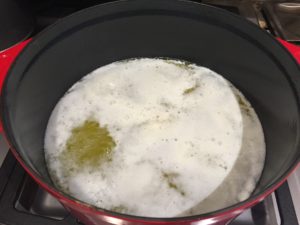
Step 3: Foam floats to the top. This is the whey which contains the casein protein and lactose separating from the butter fat.
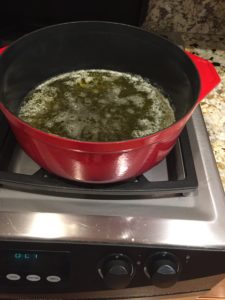
Step 7: about 26 minutes into the process and the butter fat and whey have separated. It is done and ready to strain. Turn off the burner and let it sit for a couple of minutes.
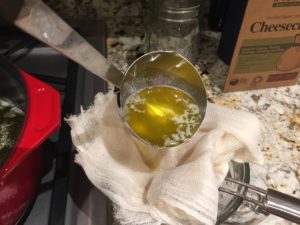
Step 8: Ladle the ghee mixture into the metal mesh covered with cheese cloth over a glass bowl. Repeat this process until all the ghee in your pot has been strained.
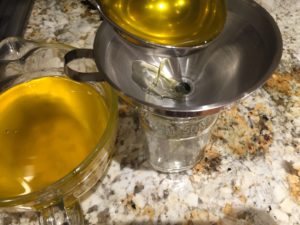
Step 9: Ladle ghee into a glass mason jar. I place most of my ghee in a large mason jar and then a smaller amount in a smaller container. I use ghee from the smaller container first then refill it from the larger container.
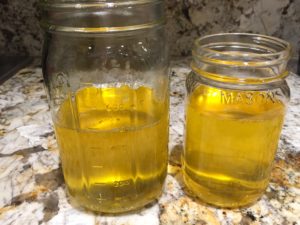
Ghee in my mason jars. Cool the ghee at room temperature on your kitchen counter. When your ghee is completely cooled, you may place the lid on it.
